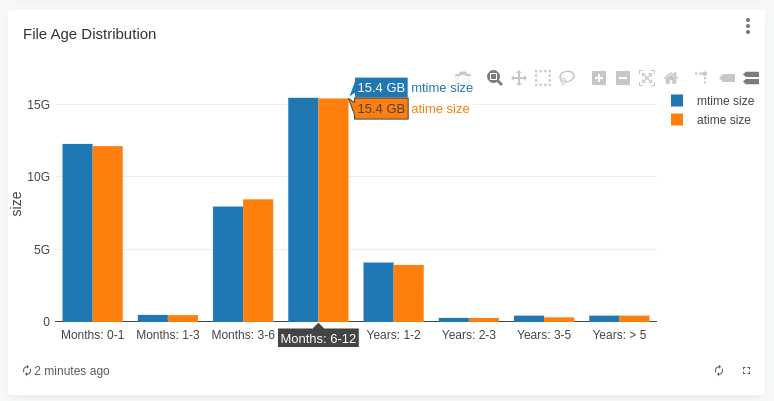Size and Units
Historically data size was interpreted as a power of 2 or 10 based on the context. For example, 4KB of storage or memory is 4096 bytes, whereas a bandwidth of 4Kbps means 4000 bytes/second.
A new set of difficult-to-pronounce terms
(known as
IEC
)
have been devised to remove this ambiguity:
| kibibyte |
| mebibyte |
| gibibyte |
| tebibyte |
| pebibyte |
| exbibyte |
Charts
Most charting libraries are based on D3, which will summarize number in powers of 10 using the SI-prefix,

While there is no way to change the X or Y scale in Plotly to use the base-2 notation, text labels can be set manually
var data = [{ values: ys['size'], /* bytes */ text: ys['size_hum'], /* KiB, MiB, ... */ // ... }]
The same stragegy for a pie chart
var data = [{ // ... textinfo: "percent", textposition: "inside", hovertemplate: '%{label}<br>%{text}<br>%{percent:.1%}<extra></extra>', }]
Conversion
In some cases lookup table can be used to provide a conversion
SELECT unit, power(10, base_10) AS "base 10", power(2, base_2) AS "base 2" FROM (VALUES ('k', 3, 10), ('M', 6, 20), ('G', 9, 30), ('T', 12, 40), ('P', 15, 50) ) powers(unit, base_10, base_2);
unit | base 10 | base 2 ------+---------------+----------------------- k | 1000 | 1024 M | 1000000 | 1048576 G | 1000000000 | 1073741824 T | 1000000000000 | 1099511627776 P | 1e+15 | 1.125899906842624e+15 (5 rows)
Since the conversion is a compounding difference, there is no single conversion factor.
Conversion Functions
PostgresSQL provides pg_size_pretty() but this only prints whole numbers. Arbitrary precision may be calculated using a custom function
CREATE FUNCTION size_iec(IN byte_size bigint, IN round_num int) returns text language plpgsql AS $$ DECLARE size numeric := byte_size; power_base smallint := 1024; prefixes text[] := ARRAY['K', 'M', 'G', 'T', 'P', 'E']; counter smallint := 1; output text; BEGIN output := byte_size::text; WHILE abs(byte_size) >= power_base AND counter <= array_length(prefixes, 1) LOOP byte_size := byte_size / power_base; size := size / power_base; output := concat(round(size, round_num)::text, ' ', prefixes[counter], 'iB'); counter := counter + 1; END LOOP; RETURN output; END; $$;